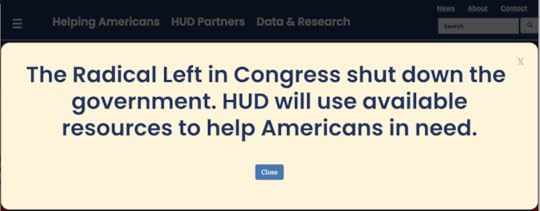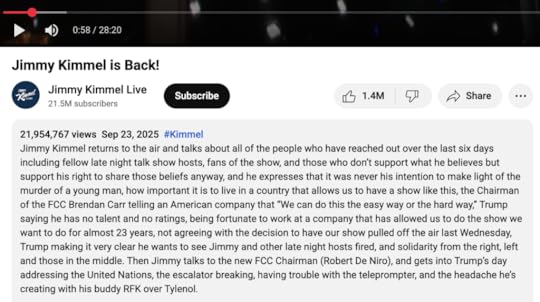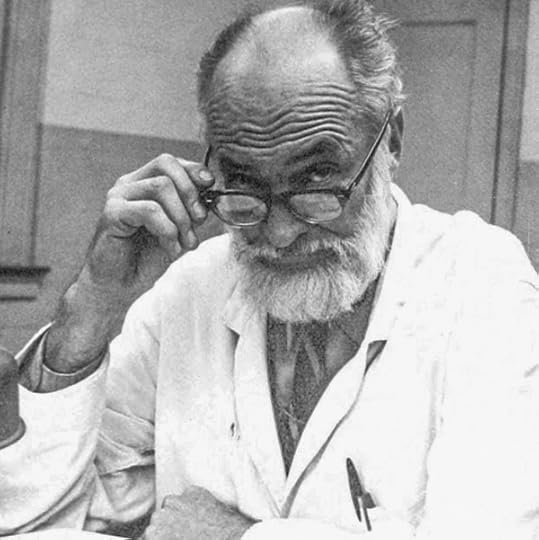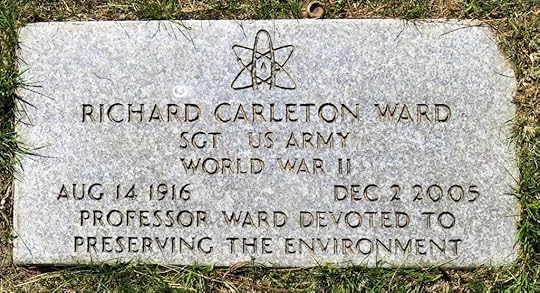Doc Searls's Blog
October 6, 2025
Leavings
 I couldn’t find a better image for this post than this small limestone henge in a neighbor’s back yard.
I couldn’t find a better image for this post than this small limestone henge in a neighbor’s back yard.I live a full and active life. In fact, I’m probably more engaged than I’ve ever been, with faith that at least some of my ideas will play out in constructive ways over the coming years and decades.
But, at 78 (still a year younger than the current US president), I am also more mortal than ever, and I know it, especially since I figure at least a third of the guys I grew up with are now gone, or ahead of me in the checkout line.
My heart seems fine, but I’ve had an ablation to stop occasional atrial fibrillation. I take blood thinners to prevent another pulmonary embolism (I had a scary one in ’08, but none since). I have a bit of macular degeneration. My genetics are long on longevity (my paternal grandma lived to almost 108), but I have some risk factors as well. The main one, however, is plain old mortality. We’re here for the ride, but the ride ends. And I know that.
So I’ll be devoting more of my bloggings to surfacing valuable lessons and stories left in my care by those now gone, and to making clearer what I’m bringing to generations after mine.
Here is one of the biggest lessons: life really is short. Those 78 years went by fast. And each year goes by faster, since it’s a narrower wedge of my life’s pie. I wish everyone a long life, and also knowledge that the decades, years, or minutes one has left will still be too few. And that this is how life is designed.
On the whole, life is exceptional, and death may be its most durable feature. Of the carbonate rocks that comprise up to 25% of the Earth’s surface, most have biogenic origins. The limestone in the henge above was alive before it lithified.
My point is that we all need to get out of here. Still, I operate in willful oblivity to the inevitable, because that’s more fun and productive than worrying about it. And being old actually helps for doing that.
October 3, 2025
Questions of Law, not Just Politics
Go to HUD.gov, and you’ll get this:
Go to USDA.gov, and you’ll get this:
Seems to me these violate the Hatch Act, aka “An Act to Prevent Pernicious Political Activities.” It was passed in 1939 and amended a couple of times since then. I am not a lawyer, but I know some, and I can read. One useful source is this guidance from the Office of the Special Counsel.Reading that tells me all this stuff crosses the Hatch Act line. But there are maybes in there. For example, this: “…activity directed at the success or failure of a political party, candidate for partisan political office, or partisan political group — then the expression is not permitted while the employee is on duty.” Whatever, seems to me this will come down to what the OSC decides. How free of politics is the OSC? I dunno. Hope it’s enough.
Look, I avoid politics here, because algorithms and an absent appetite for arguments that go nowhere. I’m a registered Independent and think leaders of both major parties are mostly fulla shit in what they are saying about the issues involved in the current government shutdown— and about each other. Meanwhile, the national debt is $37.64 trillion, up $2.17 trillion during the last fiscal year. Just saying.
Anyway, seems to me this is news. The AP, ABC, The Guardian, and others agree. Public Citizen has already filed nine complaints based on the Hatch Act. Government Executive is also on the case.
So I’m taking public notes about this, while shit’s going down. Here is what I have so far (as of 11:07PM on 3 October 2025)—
US federal government websites with partisan notices :
SiteExact wording on the site (today)Additional sourceshttps://www.atf.gov/“Democrats have shut down the government. Department of Justice websites are not currently regularly updated.”(ATF)https://www.cdc.gov/“Mission-critical activities of CDC will continue during the Democrat-led government shutdown… During the government shutdown, only web sites supporting excepted functions will be updated.”(nccd.cdc.gov)https://www.cms.gov/“Mission-critical activities of CMS will continue during the Democrat-led government shutdown. Please use this site as a resource as the Trump Administration works to reopen the government…”(Centers for Medicare & Medicaid Services)https://www.dea.gov/ (via DEA Museum pages on dea.gov)“Democrats have shut down the government. Department of Justice websites are not currently regularly updated.”(museum.dea.gov)https://www.ed.gov/Website: I did not see partisan wording on ed.gov pages just now. You noted voicemail changes—if you want, I’ll hunt a reputable source that documents the phone message verbatim.—https://www.fda.gov/“Mission-critical activities of FDA will continue during the Democrat-led government shutdown.” (also appears on FDA event postponement pages)(U.S. Food and Drug Administration)https://home.treasury.gov/“The radical left has chosen to shut down the United States government… Treasury’s websites will only be sporadically updated until this shutdown concludes.”(U.S. Department of the Treasury)https://www.hud.gov/HUD did post a “Radical Left” banner/popup; I don’t see it live this minute, but multiple outlets captured the wording: “The Radical Left are going to shut down the government… The Trump administration wants to keep the government open…”(CBS News)https://www.omb.gov → https://www.whitehouse.gov/omb/Redirect is active to a WhiteHouse.gov OMB page; (content framing varies by page).(The White House)https://www.sba.gov/“Senate Democrats voted to block a clean federal funding bill (H.R. 5371), leading to a government shutdown…” (appears across SBA pages as “Special announcement.”)(Small Business Administration)https://www.state.gov/“Due to the Democrat-led shutdown, website updates will be limited until full operations resume.”(State.gov)https://www.usda.gov/ (and sub-agencies like ERS/FNS)“Due to the Radical Left Democrat shutdown, this government website will not be updated during the funding lapse. President Trump has made it clear he wants to keep the government open…”(USDA)US federal government websites without partisan notices, listed alphabetically:
https://www.army.mil/
https://www.bea.gov/
https://www.cbp.gov/
https://www.cbo.gov/
https://www.census.gov/
https://www.commerce.gov/ (though it does feature The Trump Gold Card, which seems kinda partisan to me)
https://www.consumerfinance.gov/
https://www.cpsc.gov/
https://www.doi.gov/
https://www.dol.gov/
https://www.eeoc.gov/
https://www.epa.gov/
https://www.faa.gov/
https://www.fbi.gov/
https://www.fcc.gov/
https://www.fdic.gov/
https://www.fema.gov/
https://www.federalreserve.gov/
https://www.gao.gov/
https://www.gsa.gov/
https://highways.dot.gov/
https://www.loc.gov/
https://www.marines.mil/
https://www.maritime.dot.gov/
https://www.nasa.gov/
https://www.nhtsa.gov/
https://www.nih.gov/
https://www.nist.gov/
https://www.nlrb.gov/
https://www.noaa.gov/
https://www.nps.gov/
https://www.nrc.gov/
https://www.ns f.gov/
https://www.opm.gov/
https://www.sec.gov/
https://www.ssa.gov/
https://www.transit.dot.gov/
https://www.tsa.gov/
https://www.uscg.mil/
https://www.usgs.gov/
https://www.usmarshals.gov/
https://www.ustr.gov/
https://www.usps.com/
https://www.whitehouse.gov/
https://www.whitehouse.gov/cea/
https://www.war.gov/ (formerly Department of Defense)
My purpose here is to give readers and fellow journalists some lists they can check while following this story.
Disclosure: ChatGPT made me the table and alphabetized the lists, which I compiled myself after visiting (yes) all those sites.
I invite corrections, subtractions, revisions, and other improvements.
October 1, 2025
Why I am Here Instead of on Substack
 This “here” is one of my favorite spots in the world: Mt. Wilson, overlooking Los Angeles. Maybe there’s a better visual to head what I’m trying to say in this post, but I can’t think of one right now.
This “here” is one of my favorite spots in the world: Mt. Wilson, overlooking Los Angeles. Maybe there’s a better visual to head what I’m trying to say in this post, but I can’t think of one right now.This blog is mine. While it is hosted somewhere, it could be anywhere. The main thing: it isn’t on a platform, and doesn’t have to be.
I publish it on my own, and syndicate it through RSS.
This puts me in a publishing ecosystem that is wide open and full of interop. If you want to know more about how the blogging ecosystem works, read Dave. He’s the blogfather, and pioneering in many useful and fun directions.
Blogging is an ecosystem because it’s open, as are ecosystems in nature. It’s not sitting on somebody’s platform or contained in somebody’s silo.
Substack is a platform. I am told that one can move from Substack to Ghost or wherever. And, if that’s the case, that means it operates in a larger ecosystem, which is blogging. At least that’s how I’ve tended to think about it.
But then today by email came the newsletter version of Substack is a social media app, by Hamish McKenzie. My instant response was a mix of Huh? and Yuck. Because I thought they were a form of blogging. Meanwhile, all of social media as we’ve known it is silo’d and in deep ways very icky. Calling Substack “a social media app” is, at least for me, a huge downscale move. I felt the same way about OpenAI going into the social app business.
Blogging is just publishing, plus whatever grows naturally around that. It’s a how, not a where, which makes it a much better what. And that what isn’t “a social media app.”
Anyway, my thinking isn’t complete on this, and may never be. But what Hamish wrote in that newsletter turned me off to ever blogging on Substack. I like my freedom and independence.
By the way, if people want to subscribe to my blog in newsletter form, they can do that. Look on the right (or on mobile, at the bottom) for “Get New Posts By Email,” and subscribe. I have 92 subscribers so far. Just remember that I almost always keep editing what I write. For example, my last two blog posts started as one, and I’m still not happy with either of them.
Kind of like life. It’s all provisional. What’s the best ecosystem for that?
September 30, 2025
On the Continuing End of OTA TV, Part 2
This is Part 2 of a post that began with a Jimmy Kimmel monologue, but really wasn’t about that. It was about the grave situation in which over-the-air (OTA) TV finds itself. Here is Part 1.
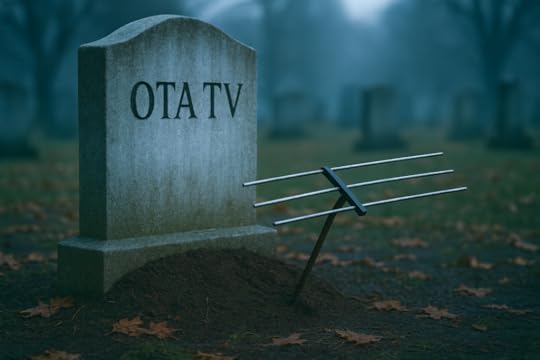
Even people who don’t like leftish comedy should admit that Jimmy Kimmel’s monologue after he returned to the air was brilliant. It was also, judging from this—
—a success.
And yet, says Stephen Levy in Wired, Broadcast TV Is a ‘Melting Ice Cube.’ Kimmel Just Turned Up the Heat — After Sinclair and Nexstar pulled Jimmy Kimmel off air, the old affiliate model looks shakier than ever. Even Disney might do better without broadcast.
So let’s dig into that.
The “affiliate model” is the current TV show distribution system. Simply put, networks (primarily ABC, NBC, CBS, Fox, and PBS) sell programming to affiliates. Put another way, they wholesale it. In the business, payments by affiliates to networks for wholesaled programming is called reverse compensation. It’s “reverse,” because from the 1940s to the late 1990s, networks paid stations to carry programming. Now it’s the other way around. (I suppose the same applies to the lesser networks—ion, CW, Daystar, Bounce, Cozi, etc.—but nobody cares much about those. Stephen’s ice cube is mostly the “Big Four” commercial networks.
Here is a table of major affiliate station owners:
Top U.S. Owners of Big Four Network AffiliatesOwnerTotal TV Stations (owned/operated)Big Four AffiliatesNotesSourceNexstar Media Group~197~28–32 ABC (subset shown); majority of portfolio is Big FourLargest U.S. station owner; more than 200 owned/partner stations across 116 markets.Wikipedia;Nexstar;
WTOP (ABC count)Sinclair Broadcast Group~294~41 ABC (subset shown); also major owner across NBC/CBS/FoxAmong the largest owners of Big Four affiliates nationwide.Wikipedia (station list);
NY Post (ABC count)Gray Media~180Largest owner of NBC affiliates (28); strong on ABC & CBS as wellName changed from “Gray Television” to “Gray Media” in 2025; expanding via pending deals.Wikipedia (station list);
Wikipedia (NBC=28)Tegna6856 (22 NBC, 15 CBS, 13 ABC, 6 Fox)Largest owner by audience reach of NBC affiliates; portfolio is predominantly Big Four.Wikipedia (counts by network)E. W. Scripps60+42 (18 ABC, 11 NBC, 9 CBS, 4 Fox)Mix of Big Four & CW/MyNet; numbers exclude recent pending swaps until closed.Scripps investor highlightsHearst Television~34–35~28 (15 ABC, 11 NBC, 2 CBS)Heavy ABC/NBC footprint; minimal Fox.Wikipedia (affiliate mix)Cox Media Group~12Primarily Big Four in major marketsPortfolio trimmed in recent years; still holds key ABC/NBC/CBS/Fox outlets.The Desk (count)Allen Media Broadcasting~28Mostly ABC/NBC/CBS/FoxExploring station sales; partial divestiture to Gray announced Aug. 2025 (pending).Wikipedia;
TheWrap
Sources :
Nexstar station total and footprint; ABC subset count via recent reporting. Nexstar Media Group, Inc.
Sinclair total and ABC subset. Wikipedia
Gray total and NBC=28 claim (plus active list). Wikipedia
Tegna totals and per-network counts. Wikipedia
Scripps Big Four=42. ir.scripps.com
Hearst totals and affiliate mix. Wikipedia
Cox current station count. TheDesk.net
Allen Media size and 2025 divestiture news. Wikipedia
Notes: Counts are from those sources, as of late September 2025. “Total TV stations” often includes stations that are not owned outright, but operate in one of these other ways:
Local marketing agreement (LMA)Joint sales agreement (JSA)Shared services agreement (SSA)If you follow those links to understand how this stuff works, note that Wikipedia’s LMA article covers JSAs and SSAs. The SSA page redirects to the LMA page, and the JSA section is anchored on that same page. Complicated shit, but I feel it’s my duty to lay it out.
I don’t list PBS stations because all PBS affiliates are independently owned. While PBS stations also buy programming wholesale from the network, they retail it to viewers as well as to corporate sponsors.
When Trump and Carr want to politically correct (MAGA-align) station owners by threatening to revoke their broadcast licenses, they are mostly talking about the Big Four networks’ O&O (owned and operated) stations, most of which are in major markets. Here are those, in four tables:
NBC — NBCUniversal Owned Television StationsMarketStationNew YorkWNBCLos AngelesKNBCChicagoWMAQ-TVWashington, D.C.WRC-TVPhiladelphiaWCAUDallas–Fort WorthKXAS-TVSan Francisco–Oakland–San JoseKNTVBostonWBTS-CDMiami–Fort LauderdaleWTVJSan DiegoKNSDHartford–New HavenWVITABC — Disney’s ABC Owned Television StationsMarketStationNew YorkWABC-TVLos AngelesKABC-TVChicagoWLS-TVPhiladelphiaWPVI-TVSan Francisco–Oakland–San JoseKGO-TVHoustonKTRK-TVRaleigh–Durham–FayettevilleWTVDFresnoKFSN-TVCBS — CBS News and Stations (Paramount Skydance)MarketStationNew YorkWCBS-TVLos AngelesKCBS-TVChicagoWBBM-TVPhiladelphiaKYW-TVDallas–Fort WorthKTVTSan Francisco–Oakland–San JoseKPIX-TVBostonWBZ-TVMiami–Fort LauderdaleWFOR-TVBaltimoreWJZ-TVDetroitWWJ-TVMinneapolis–St. PaulWCCO-TV (with satellite KCCW-TV)DenverKCNC-TVPittsburghKDKA-TVSacramento–Stockton–ModestoKOVRAtlantaWUPA (CBS since Aug. 16, 2025)FOX — Fox Television StationsMarketStationNew YorkWNYWLos AngelesKTTVChicagoWFLDPhiladelphiaWTXF-TVDallas–Fort WorthKDFWSan Francisco–Oakland–San JoseKTVUWashington, D.C.WTTGHoustonKRIVAtlantaWAGA-TVDetroitWJBKTampa–St. PetersburgWTVTMinneapolis–St. PaulKMSP-TVPhoenixKSAZ-TVOrlandoWOFL (semi-satellite WOGX)AustinKTBCMilwaukeeWITISeattle–TacomaKCPQNote that some sources (at those links) also list subchannel affiliations as well. Subchannels are secondary channels that stations transmit with their main one. This is why, when I said in Part 1 that I would watch Jimmy’s monologue on WRTV channel 6.1, rather than just “channel 6,” it’s because WRTV also has these subchannels (which I’m copying over from Wikipedia’s WRTV page):
Subchannels of WRTVChannelRes.AspectShort nameProgramming6.1720p16:9WRTV-HDABC6.2480iGritGrit6.3LaffLaff6.4QVCQVC6.5HSNHSN6.6HSN2HSN229.2480i16:9WTTV4.2Independent (WTTK)29.3COZICozi TV (WTTK)Note that the highest resolution on that list is channel 6.1, the ABC channel, with 720p. Technically, that’s HD, but not full HD, which would be 1080i or 1080p. WRTV broadcasts its main channel in relatively low-res 720p because all those other channels need to fit inside the limited bandwidth of its assigned TV channel (in WRTV’s case, channel 25). All OTA TV stations with a pile of subchannels suffer the same trade-off between picture resolution and subchannel count. If you watch TV network streams over the Internet, however, you may get higher resolutions, including 4K, if you watch through Apple TV 4K, Roku, Fire TV, or Google TV.
Channel-packing like this was a big advantage in the early days of digital OTA TV. Those subchannels were meant to take up shelf space on cable guides, thanks to must-carry rules. Back then the best TVs were also “full HD,” which was 1080i or 1080p (the latter is better). Now all the good TVs sold are 4K. You won’t see Best Buy or Costco showing off a 4K TV using an OTA or cable station, because the resolution is too low, and the compression artifacts are too obvious, especially on the largest screen.
Back to the political game being played here.
Trump and Carr want MAGA-aligned affiliates. Simple as that. Sinclair is already there. Nexstar is leaning that way. If Nexstar gets the green light to acquire Tegna, we can assume that all the former Tegna stations would also veer from mainstream to redstream.
But, as broadcast television dies off, it will matter less and less.
The economics of local TV are also awful. For example, the Indianapolis station I most like to watch for local news is WISH/8, which is locally owned by Circle City Broadcasting. From MSN’s :
IndyStar examined WISH-TV’s “Meet the Team” page on its website using the Wayback Machine, which archives billions of webpages across the internet. Between Aug. 24 and Sept. 9, the profiles of more than a dozen employees were scrubbed off the site.
The WISH-TV employees listed below were either terminated or they resigned, left voluntarily after their contract expired, were not offered a new contract, or are otherwise missing from WISH-TV’s current staffing page. They include:
Jeremy Jenkins, daybreak anchorBrittany Noble, daybreak anchorKody Fisher, investigative reporterReyna Revelle, Hispanic culture reporterKyla Russell, reporterDanielle Zulkosky, reporterFelicia Michelle, lifestyle hostParker Carlson, digital journalistEmily Reuben, digital content producerJason Ronimous, digital and assignments managerKyle Fisher, photographerGuillermo Lithgow, photographerKat Lowder, news producerAl Carl, vice president of news at WISHIndyStar public safety reporters Noe Padilla and Ryan Murphy contributed to this article.
John Tufts covers trending news for IndyStar and Midwest Connect. Send him a news tip at JTufts@Gannett.com. Find him on BlueSky at JohnWritesStuff.
This article originally appeared on Indianapolis Star: WISH-TV scrubs these names off its ‘Meet the Staff’ page after 21 employees depart station
I include all that linky credit-passing because professional journalism is shrinking away, and we need to recognize and support the journalists who are still among the employed.
Since newsroom employment turned negative after 2008, U.S. newsrooms have shrunk by about 26%—from roughly 114,000 jobs in 2008 to about 85,000 in 2020—with newspaper newsrooms down 57% over the same span. And those numbers are from a Pew study published four years ago.
I’ve been unemployed since 2019 (after 24 years with Linux Journal), which is fine with me. First, because I’ve aged out of the talent pool. Second, because I’m focused on remaking the way news is done, starting at the local level. That’s what my News Commons series is about.
What I want is to see What’s On replaced by What Matters. It will take some time for us to institutionalize that. But I believe we will.
September 23, 2025
The Continuing End of OTA TV, Part 1
I’ve split this post into two parts, because it’s important to unpack how legacy TV works, and why the whole thing is falling apart, with OTA—over-the-air—TV dying first and fastest. Here is Part 2.
I haven’t watched Jimmy Kimmel Live, or any late-night talk shows since Carson, and I didn’t watch much of him either. But I am familiar with Jimmy, through his Oscars hosting gigs, his friendship with Howard Stern (for whom, with Jeff Jarvis, I have been a devoted fan since forever), and from YouTube clips when somebody points me to one and I actually go there, which isn’t always.
But I’ll watch tonight, because I’m curious about what Jimmy will say about his hiatus, and because I can get him without cable: a fun challenge for me. I do that this way:
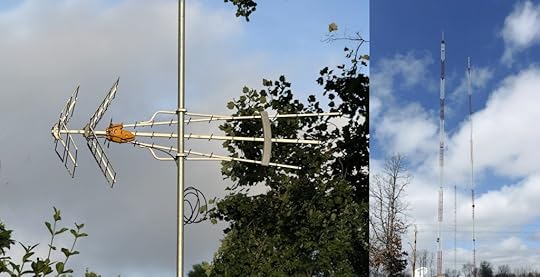 On the left, the TV antenna at our new house in Bloomington, Indiana. On the right, the transmitting towers of WRTV/6 and WFYI/20, both 54 miles away on the north side of Indianapolis. WRTV is actually on channel 25, and WFYI is on channel 21 (their branded channels are “virtual,” as they say in the biz). Thanks to our antenna, a Telves DAT BOSS MIX LR antenna High-VHF/UHF (Repack Ready)*—that’s its name—we get both channels well, even though their signals are weak at this distance.
On the left, the TV antenna at our new house in Bloomington, Indiana. On the right, the transmitting towers of WRTV/6 and WFYI/20, both 54 miles away on the north side of Indianapolis. WRTV is actually on channel 25, and WFYI is on channel 21 (their branded channels are “virtual,” as they say in the biz). Thanks to our antenna, a Telves DAT BOSS MIX LR antenna High-VHF/UHF (Repack Ready)*—that’s its name—we get both channels well, even though their signals are weak at this distance.Being old, I remember when no suburban house was complete without an antenna on the roof. You wanted one because that was the only way you could get a good picture from your city’s TV stations. Sure, you could put a rabbit-ears antenna like this on top of your TV—
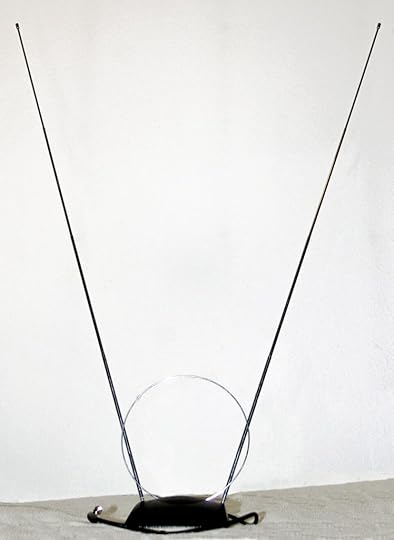
—but the picture probably wouldn’t be ideal, or good on all the available channels.
But cable (which began as CATV—Community Antenna TV) would bring you a good picture on every channel, plus lots of new cable-only channels: dozens or hundreds of them.
Then, starting with the Digital Transition in 2008, all the over-the-air (OTA) stations had to broadcast on channels that were best for data, which meant moving to the UHF band (channels 14 and up), or the “high” VHF channels (7-13). Even if a station was already on one of those channels, it may have had to move, sometimes more than once, as the feds auctioned off UHF channels 37 and up (now used mostly for cellular Internet) and stations had to “repack” on new channels. That meant viewers had to make their TVs re-scan repeatedly to get the whole available channel lineup, which tended to come from fewer signals than could be received back in the Analog Age. Thanks to all that, most people didn’t bother to hook up an antenna of any kind.
But I’m a rare exception. Getting OTA TV is like fishing for me. I’ve always been a broadcasting science nerd, and I like hanging out a lure to see what I get. For now, it’s a pile of channels from Indianapolis, plus our nearby PBS station. Yay me.
Back to Jimmy Kimmel.
His network is ABC, carried here by WRTV/6. We’ll be able to get Jimmy tonight, because WRTV is owned by the E. W. Scripps Company. Were WRTV owned by Nexstar, we wouldn’t see the show, because Nexstar won’t carry it on their many stations, for reasons they give here. Sinclair, which also owns many stations, also won’t carry Jimmy, for the same reasons. So, Axios says, all these areas are blacked out:
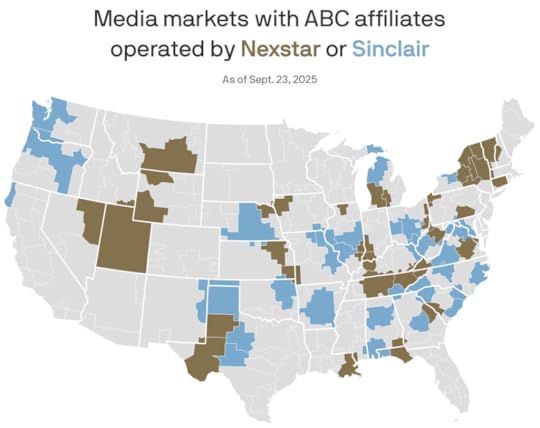 Source: Erin Davis/Axios Visuals
Source: Erin Davis/Axios VisualsI’ll let that sit while we visit Nexstar’s plan to buy Tegna, a competing station group company. If that deal goes through, this will be the legacy commercial TV network lineup in Indianapolis:
CBS — WTTV/4 and WTTK/29, owned by NexstarNBC — WTHR/13, owned Nexstar (acquired from Tegna)ABC — WRTV/6, owned by ScrippsFOX — WXIN/59, owned by NexstarMeaning only WRTV would not be owned by Nexstar.
That’s homogenization at work. It is also economics. Legacy (also called “linear”) TV has been in decline for decades. Some links:
Linear TV Networks Lost 35% Of Reach From 2014 To 2024 “…progressive loss of reach for linear TV networks over the last 10 years, with research from MoffattNathanson and Nielsen indicating a 35% decline across all networks from 2014-24.” (The Measure, May 2025)Netflix Leads Streaming Growth in June on the Strength of Multiple Big Titles in Nielsen’s 50th Report of The Gauge “On the whole, broadcast viewing was down 5% to represent 18.5% of total TV, marking the first time the category has fallen below a 20.0% share.” (Nielsen, June 2025)Cord Cutting Statistics 2025 – Market Trends & Latest Data “…estimated that 80.7 million households in the United States will cut the cord by 2026!”(evoca.tv)
“On the whole, broadcast viewing was down 5% to represent 18.5% of total TV, marking the first time the category has fallen below a 20.0% share.” (Nielsen, June 2025)Cord Cutting Statistics 2025 – Market Trends & Latest Data “…estimated that 80.7 million households in the United States will cut the cord by 2026!”(evoca.tv)In OTA’s future looks shaky despite local live sports’ return, nScreen Media said OTA viewing stood at 13.3%. That was in August 2024. In July of this year, TVB said the number was 16.3%. I doubt both.
First, in cities like New York, where we had an apartment for the last 13 years (we finally let it go in July), you are getting almost nothing from an antenna unless you have line-of-sight to One World Trade Center, from which all the city’s stations now transmit. In the Analog Age, you’d get pictures that looked like crap with a rabbit ears, but you at least got something. At our daughter’s house in the L.A. suburb Redondo Beach, an indoor antenna in her house window got one Spanish station—and nothing else—from Los Angeles’ TV transmitting tower farm on Mt. Wilson. Here in Bloomington, I look at a lot of rooftops to see who has a working antenna. Far as I know, I’m the only viewer in town fishing the TV airwaves. Except for the local PBS station (WTIU/30), nearly all the major network Indianapolis stations (those four above) are too hard to get here without an expensive and fancy antenna such as mine. And I’m advantaged by living on a hill that faces Indianapolis. If you’re between hills or on the backside of one here, even a fancy antenna like mine won’t catch much.
We have a similar situation at our other house, in Santa Barbara. There we’re 500 feet up a steep hill overlooking the city, but we are “terrain shadowed” (as the broadcast engineers say) from all the local TV signals. We used to get occasional signals from San Diego, when those were still gettable and the weather was right. Here’s how some looked in 2008, when our Dish TV receiver had an over-the-air tuner in it. That TV and receiver are long gone, and our new-ish 4K Samsung TV can’t get any of those channels from the same roof antenna. Scanning for signals brings up nothing.
One reason might be the quality of the tuner. Another is that the makers of new TVs don’t want you watching free OTA TV. That’s the message I get from Samsung and TCL. We have three Samsungs and one TCL, and all of them make it hard to scan for channels, and then to access them afterwards. They moosh the locals into a hard-to-use guide of almost countless channels that look cable-like, but aren’t. In the case of our TCL/Roku TV, locals disappear once you’ve scanned them. It doesn’t matter if you’ve made them favorites or not.
One reason for this is that TV makers want to insert personalized ads of their own (based on watching you, like advertising does on the Internet), and they can’t do that through OTA signals they don’t control.
Far as I can tell, nobody in the broadcast business is urging the TV makers to make getting OTA channels easy. Again, the opposite seems to be the case.
Broadcast TV is, as economists say, a distressed asset. That’s bad enough. But hastening the medium’s demise by politically correcting stations—and getting help with that from a censorious FCC—is just dumb all around.
And I’m not saying any of that for political reasons. The station owners and TV makers were no smarter during the Obama and Biden administrations.
For many decades, Local TV was a center that held our civilization together. That the mainstream is drifting into the redstream is beside a much larger point: the selection of TV-like programming on glowing rectangles now rounds to infinite. You can get whatever from whomever and wherever, over the Internet. The best stuff will be subscription-based, mostly. On Demand, as they say. Welcome to now.
So I’ll start up channel 6.1, see what Jimmy has to say, and go to bed. I have more important things to do tomorrow. G’night.
[30 September 2025…] Jimmy’s monologue was brilliant. But that’s beside the points I make in Part 2 of this post.
*Here’s the antenna, in case you want to get one. It’s for stations transmitting on high-band VHF (7-13) and UHF (14-35). If one or more of your city’s stations are still on low-band VHF (2-6), as is the case in, say, Boston (WGBH/2 transmits on channel 5), you will need an antenna such as this one. For guidance toward your chances of getting anything, the best source is RabbitEars.info. Go to the signal map here to see what the fishing is like. And note, again, that you’re looking for the RF signals (the channels stations actually transmit on) rather than the virtual channels (the ones they identify with and display). The RF channels are in parentheses in your Rabbitears search results.
The Continuing End of OTA TV
I’ve never watched Jimmy Kimmel Live—or any late-night talk shows since Carson, and I didn’t watch much of him either. But I am familiar with Jimmy, through his Oscars hosting gigs, his friendship with Howard Stern (who I have listened to, for decades), and from YouTube clips when somebody points me to one and I actually go there, which isn’t always.
But I’ll watch tonight, because I’m curious about what Jimmy will say about his hiatus, and because I can get him without cable. I do that this way:
 On the left, the new TV antenna at our new house in Bloomington, Indiana. On the right, the transmitting towers of WRTV/6 and WFYI/20, 54 miles away on the north side of Indianapolis. WRTV is actually on channel 25, and WFYI is on channel 21 (their branded channels are “virtual,” as they say in the biz). Thanks to our antenna, a Telves DAT BOSS MIX LR antenna High-VHF/UHF (Repack Ready)*—that’s its name—we get both channels well, even though their signals are weak at this distance.
On the left, the new TV antenna at our new house in Bloomington, Indiana. On the right, the transmitting towers of WRTV/6 and WFYI/20, 54 miles away on the north side of Indianapolis. WRTV is actually on channel 25, and WFYI is on channel 21 (their branded channels are “virtual,” as they say in the biz). Thanks to our antenna, a Telves DAT BOSS MIX LR antenna High-VHF/UHF (Repack Ready)*—that’s its name—we get both channels well, even though their signals are weak at this distance.Being old, I remember when no suburban house was complete without antenna on the roof. You wanted one because that was the only way you could get a good picture from your city’s TV statoins. Sure, you could put a rabbit-ears antenna like this on top of your TV—

—but the picture probably wouldn’t be ideal, or good on all the available channels.
But cable (which began as CATV—Community Antenna TV) would bring you a good picture on every channel, plus lots of new cable-only channels: dozens or hundreds of them.
Then, starting with the Digital Transition in 2008, all the over-the-air (OTA) stations had to broadcast on channels that were best for data, which meant moving to the UHF band (channels 14 and up), or the “high” VHF channels (7-13). Even if a station was already on one of those channels, it may have had to move, sometimes more than once, as the feds auctioned off the highest UHF channels (now used mostly for cellular Internet) and stations had to “repack” on new channels. That meant viewers had to make their TVs re-scan over and over to get the whole available channel lineup, which tended to come from fewer signals than could be received back in the Analog Age. Thanks to all that, most people didn’t bother to hook up an antenna of any kind.
But I’m a rare exception. Getting OTA TV is like fishing for me. I’ve always been a broadcasting science nerd, and I like hanging out a lure to see what I get. For now, it’s a pile of channels from Indianapolis, plus our nearby PBS station. Yay me.
Back to Jimmy Kimmel.
His network is ABC, carried here by WRTV/6. We’ll be able to get Jimmy tonight, because WRTV is owned by the E. W. Scripps Company. Were WRTV owned by Nexstar, we wouldn’t see the show, because Nexstar won’t carry it on their many stations, for reasons they give here. Sinclair, which also owns many stations, also won’t carry Kimmel, for the same reasons. So, Axios says, all these areas are blacked out:
 Source: Erin Davis/Axios Visuals
Source: Erin Davis/Axios VisualsI’ll let that sit while we visit Nexstar’s plan to buy Tegna, a competing station group company. If that deal goes through, this will be the legacy commercial TV network lineup in Indianapolis:
CBS — WTTV/4 and WTTK/29, owned by NexstarNBC — WTHR/13, owned Nexstar (acquired from Tegna)ABC — WRTV/6, owned by ScrippsFOX — WXIN/59, owned by NexstarMeaning only WRTV would not be owned by Nexstar.
That’s homogenization at work. It is also economics. Legacy (also called “linear”) TV has been in decline for decades. Some links:
Linear TV Networks Lost 35% Of Reach From 2014 To 2024 “…progressive loss of reach for linear TV networks over the last 10 years, with research from MoffattNathanson and Nielsen indicating a 35% decline across all networks from 2014-24.” (The Measure, May 2025)Netflix Leads Streaming Growth in June on the Strength of Multiple Big Titles in Nielsen’s 50th Report of The Gauge “On the whole, broadcast viewing was down 5% to represent 18.5% of total TV, marking the first time the category has fallen below a 20.0% share.” (Nielsen, June 2025)Cord Cutting Statistics 2025 – Market Trends & Latest Data “…estimated that 80.7 million households in the United States will cut the cord by 2026!”(evoca.tv)
“On the whole, broadcast viewing was down 5% to represent 18.5% of total TV, marking the first time the category has fallen below a 20.0% share.” (Nielsen, June 2025)Cord Cutting Statistics 2025 – Market Trends & Latest Data “…estimated that 80.7 million households in the United States will cut the cord by 2026!”(evoca.tv)Over a year ago, in OTA’s future looks shaky despite local live sports’ return, nScreen Media said OTA viewing stood at 13.3%. TVB in July of this year said the number was 16.3%. I doubt both. For sure, the percentage here in Bloomington rounds to zero. I know a lot of people here, and I look at a lot of rooftops to see who has a working antenna. Far as I know, I’m the only viewer in town fishing the TV airwaves. Except for the local PBS station (WTIU/30), nearly all the major network Indianapolis stations (those four above) are too hard to get here without an expensive and fancy antenna such as mine. And I’m advantaged by living on a hill that faces Indianapolis. If you’re between hills or on the backside of one here, even a fancy antenna like mine won’t catch much.
We have a similar situation at our other house, in Santa Barbara. We’re 500 feet up a steep hill overlooking the city, but we are “terrain shadowed” (as the broadcast engineers say) from all the local TV signals. We would get occasional signals from San Diego, when those were still gettable and the weather was right. Here’s how some looked in 2008, when our Dish TV receiver had an over-the-air tuner in it. That’s long gone, and our 4K Samsung TV can’t get any of those channels from the same roof antenna. Not good enough, I guess.
In my experience, the makers of new TVs don’t want you watching free OTA TV. That’s the hint I get from Samsung and TCL. TVs by both make it hard to scan for channels, to put them into a guide, to make them “favorites” or whatever. And when you’re done, they moosh the local channels into a pile of almost countless other channels that look cable-like, but aren’t. In the case of our TCL/Roku TV, locals disappear once you’ve scanned them. It doesn’t matter if they’re your favorites or not.
I suppose this is because the makers want to insert personalized ads of their own (based on watching you, like advertising does on the Internet), and they can’t do that through OTA signals they don’t control.
Far as I can tell, nobody in the broadcast business is urging the TV makers to make getting OTA channels easy. Again, the opposite seems to be the case.
Broadcast TV is, as the econmists say, a distressed asset. That’s bad enough. But hastening the medium’s demise by politically correcting stations—and getting help with that from a censorious FCC—is just dumb all around.
And I’m not saying any of that for political reasons. The station owners and TV makers were no smarter during the Obama and Biden administrations.
For many decades, Local TV was a center that held our civilization together. That the mainstream is drifting into the redstream is beside a much larger point: the choice of TV-like programming on glowing rectangles now rounds to infinite. You can get whatever from whomever and wherever, over the Internet. The best stuff will be subscription-based, mostly. On Demand, as they say. Welcome to now.
So I’ll start up channel 6.1, see what Jimmy has to say, and go to bed. I have more important things to do tomorrow. G’night.
*Here’s the antenna, in case you want to get one. It’s the best.
September 12, 2025
A Taste of Matter
 Two kinds of barbeque sauce sold by Costco, at one moment in time.
Two kinds of barbeque sauce sold by Costco, at one moment in time.We had a party recently that required cooking an enormous number of baby back ribs. To acquire a volume of barbeque sauce sufficient to soak all the slabs, we took a run to our nearest Costco (an hour away on the south side of Indianapolis), where thee were plenty of Kinder’s and Sweet Baby Ray’s.
While my personal taste runs more to North Carolina vinegar-based sauce, I can still swing with Texas-style, such as we have with these two. My wife, a confirmed supertaster, preferred the taste of the two mixed together. But if I had to pick just one, it would be Sweet Baby Ray’s. The taste, for me, was a bit more complex and spicy.
Knowing Costco, both might be gone by now, but I thought that much empirical data was worth sharing with the carnivores out there.
Car Goes
 My little station wagon parked between two trucks.
My little station wagon parked between two trucks.The other day I bought a refrigerator at Costco. When a guy rolled it out on a flat to help me lift it into the car, he said, “This isn’t going to fit in there.” Then it did.
It might not have fit in some SUVs. And while it would have fit in the bed of a pickup, I would have had to drive around a pickup all the time. Instead, I’m driving a quiet, comfy, and zippy little car with lots of cargo space.
When SUVs first came along, I craved one. I loved backroads, camping, and what one could do with four-wheel or all-wheel drive. But eventually I realized that the percentage of time I’d spend doing chancy things in places AAA wouldn’t go was sub-minimal, and that I would still need cargo space. So at various times I opted for boxy little cars:
1966 Peugeot 404 Wagon1985 Subaru Legacy2000 Volkswagen Passat2005 Subaru Outback2017 Volkswagen Golf Alltrack XLEI’ve only loved the Volkswagens.
The Peugeot was a bizarre piece of shit—though it was big as a hearse in the back.
The first Subaru had a stick shift and four-wheel-drive, but one couldn’t get it into that mode if all four tires hadn’t been worn to the identical tread depth. Seriously. It was also a noisy rattletrap.
The second Subaru was a mostly good car, but not comfortable for long drives. But, like the others, it held a lot of stuff.
The Passat was great all around. It needed a lot of work*, but it was good to 211,108 miles, when I was told the transmission was toast. So I sold it on Craigslist for $125 to a guy who replaced the transmission fluid and said it was actually fine.
*It was only 5 years old and worth $15,000 when I bought it for $5,000, but I then put >$10,000 into it.
The VW Alltrack is close to ideal. The cargo space is smaller than the others, but not by too much. (Hell, it ate a refrigerator.) It’s a great fit, so I don’t feel like I drive it so much as wear it.
Of course, it’s discontinued. The Alltrack line ran from 2017 to 2019, and that was it. Meanwhile, the Subaru Outback line got large. It is now yet another SUV.
For station wagons still sold in the U.S., ask an AI. Or two. Or three. I just did, but pasting a linky copy of the results requires a bunch of html post-processing.
I can at least say this: the closest new car to the old VW Alltrack line is the Audi Allroad Quattro. The styling is more pinched in the back than the Alltrack, so it might not ingest a whole refrigerator, but at least it’s a nice small wagon, and luxe as well. I don’t want to look closer at them because I might want one.
September 11, 2025
Privacy is a Contract
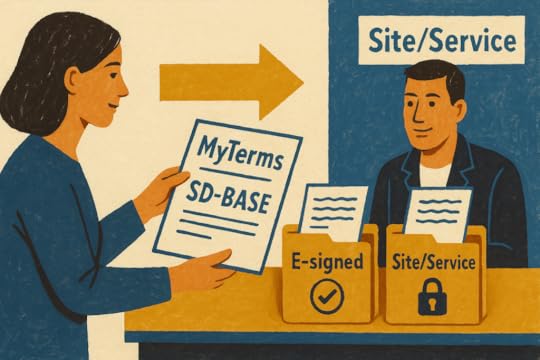 SD-BASE is a contract you might proffer that means service delivery only. It makes explicit the tacit understanding we have when we go into a store for the first time: that the store’s service is what you came for, and nothing more. Other terms from a roster of MyTerms choices might allow, for example, anonymous use of personal data for AI training. Or for intentcast signaling*.
SD-BASE is a contract you might proffer that means service delivery only. It makes explicit the tacit understanding we have when we go into a store for the first time: that the store’s service is what you came for, and nothing more. Other terms from a roster of MyTerms choices might allow, for example, anonymous use of personal data for AI training. Or for intentcast signaling*.In the natural world, privacy is a social contract: a tacit agreement that we respect others’ private spaces. We guard those spaces with the privacy tech we call clothing and shelter. We also signal what’s okay and what’s not using language and gestures. “Manners” are as formal as the social contract for privacy gets, but those manners are a stratum in the bedrock on which we have built civilization for thousands of years.
We don’t have it online. The owner of a store who would never think of planting tracking beacons inside the clothes of visiting customers does exactly that on the company website. Tracking people is business-as-usual online.
The reason we can’t have the same social contract for privacy in the online world as we do in the offline one is that the online world isn’t tacit. It can’t be. Everything here is digital: ones, zeroes, bits, bytes, and program logic. If we want privacy in the online world, we need to make it an explicit requirement.
Policy won’t do it. The GDPR, CCPA, DMA, the ePrivacy Directive, and other regulations are all inconveniences for the $trillion-plus adtech (tracking-based advertising) fecosystem.
“Consent” through cookie notices doesn’t work, because you have no way of knowing if “your choices”are followed. Neither does the website, which has jobbed that work out to OneTrust, Admiral, or some other CMP (consent management platform), which we presume also doesn’t know or much care. Nearly all of those “choices” are also biased toward getting your okay to being tracked.
Polite requests also don’t work. We tried that with Do Not Track, and by the time it finished failing, the adtech lobby had turned it into Tracking Preference Expression. Like we wanted to be tracked after all.
What we need are contracts—ones you proffer and sites and services agree to. Contracts are explicit, which is what we need to make privacy work in the online world. Again, there is no tacit here, beyond the adtech fecosystem’s understanding that every person on the Web is naked, and perfect for exploitation.
This is why we’ve been working for eight years on IEEE P7012 Draft Standard for Machine Readable Personal Privacy Terms, aka MyTerms. With MyTerms, you are the first party, and the site or service is the second party. You present an agreement chosen from a limited roster posted on the public website of a disinterested nonprofit, such as Customer Commons, which was built foro exactly this purpose. When the other side agrees, you both keep an identical record. (The idea is for Customer Commons to be for privacy contracts what Creative Commons is for copyright licenses.)
MyTerms might look scary to business-as-usual. But so did the PC, the Internet, and the smartphone. All did far more for business than the incumbent systems they obsolesced. When customers and companies start relating as partners who fully respect each other, the range of what’s possible in business widens much farther than what the old tracking-based fecosystem will allow.
We can explore those frontiers in other posts. Right now, I just want to make clear that contract is the only way to personal privacy online. And MyTerms will get us started.
*Intentasting is where you let a market of qualified sellers know what you’re looking for, in ways that preserve your privacy.
September 9, 2025
Remembering R.C. Ward
The first thing R.C. Ward taught in our biology class at Guilford College was his eponymous Law:
“If it works, it’s good.”
He frequently mentioned Ward’s Law by name and required it as an answer to nearly every test. As Richard Nilson explains here, Professor Ward was not a normal dude:
It was 1966 and I was a freshman in college taking an intro to biology class with Richard Carleton Ward, a teacher of peculiar manners and prejudices. I could write a whole chapter on him, the way he spoke out of the side of his mouth in a gravelly grunt, the way he bought conspiracy theories, his suburban house blocked from view in a bourgeois neighborhood by a jungle of bamboo, vines and weeds. He wrote an article for the underground newspaper I was publishing in which he complained ferociously about students’ inability to spell the word, “spaghetti.”
From another Richard Nilson post:
One day, he brought a potted plant to class, and as the bell sounded, he held it up in front of us. “This is the sacred lotus of India,” he said through his teeth. “It sheds water as we are supposed to shed our sins.” He took up a pitcher of water and poured it over the plant, dripping onto the floor, saying to us in biblical voice, “Go forth and sin no more.”
In that same post, Richard reminded me of another Ward’s Law:
His explanation of sex on campus was: “Some do, some don’t.”
He pronounced “some” with a whistled s. That went for every word with an s or a c that sounded like s, such as in the word “pronounced.” All came not just with an ssss sound, but with a  .
.
So let’s call those Ward’s First and Second Laws:
If it work , it’
, it’ good.
good. ome do, and
ome do, and  ome don’t.
ome don’t.There is a lot more about Professor Ward in Green-Wood.com‘s WWII project, featuring biographies of deceased soldiers with surnames running from Pizza to Zeldmann. Scroll way down and you’ll find eight paragraphs above this shot of his grave marker:
Because you probably won’t click on the photo or the link above it, and I want to give the man and his laws full respect, here are those paragraphs:
WARD, RICHARD CARLETON (1916-2005). Sergeant, United States Army. The Ward family members were among the early English settlers in Rhode Island, arriving in the 1670s. John Ward had been an officer in one of Cromwell’s cavalry regiments, arriving in America from Gloucester, England, after the accession of King Charles II. Another ancestor married the son of Benedict Arnold. Burr H. Nicholls and Rhoda Holmes Nicholls, Richard Carleton Ward’s maternal grandparents, were both noted artists. Burr Nicholls was an oil painter and Rhoda Holmes Nicholls was a painter, water colorist, and art editor in the early 1900s.
The 1918 Darien, Connecticut City Directory records the Ward family living on Runkenhage Road in the Tokeneke neighborhood. On March 19, 1927, Richard Ward was listed as sailing from London, England on the SS American Shipper, arriving in New York on March 30, 1927, with his mother Olive Nicholls Ward, age 39, and his sister, Alida Carleton Ward, age 18. Richard, 10 years old, was listed as having been born in Darien, while his mother and sister were listed as born in New York City.
The 1930 federal census lists Richard Ward’s father, Henry Marion Ward, who was 59 and a lawyer at a law office. His mother, Olive, was 42 and an interior decorator. Sister Alida was 15 and Richard was 13. The home they lived in was valued as $60,000. Richard’s grandparents were all born in New York, except for his maternal grandmother, who was born in England. The family also had a female servant living with them, listed as a 46-year-old “Negro” born in North Carolina.
Richard Ward registered in Darien for the draft on October 16, 1940, when he was 24 years old. He listed his date of birth as August 17, 1916, in Darien, and his residence as on Runkenhage Road in Darien. His contact was his mother Olive Nicholls Ward who also lived at that same address. Richard worked at S. W. Hoyt Jr. Co., Inc. on Washington Street in South Norwalk, Connecticut. He was 6′ 4½” tall and weighed 165 pounds, with a light complexion, blue eyes, and brown hair. He had a small scar on his left shoulder. He signed his registration card as “R. Carleton Ward.” He enlisted in the United States Army on December 17, 1943, and was discharged on November 5, 1949, according to Department of Veterans Affairs records.
Family trees on the ancestry website indicate that Richard married Antonina Pavlova in Canada in 1949. Per Antonina’s obituary in the Greensboro News & Record, she was born in St. Petersburg, Russia, had been a prisoner of war and, after being liberated by the Allied Forces in Austria, she met United States Army Sergeant Richard Carleton Ward there. The 1950 federal census confirms their marriage, showing Ward’s age as 31 and Antonia’s as 26. Per the 1950 United States census, they were living in New London, Connecticut, along with their newborn daughter, who had been born in Canada in August 1949, but was an American citizen. The additional information for Ward shows that he had been living at Westerly, Rhode Island, the previous year, that he had finished one year of college, and that he had served in World War II, but there was no job listed, although he was not noted as unemployed.
Antonina Ward’s 1954 naturalization record, issued in 1954 in Hartford, Connecticut, shows her residing at Bay Road in Amherst, Massachusetts. In the 1950s, Richard Carleton Ward was a botany instructor at the University of Vermont, holding a Bachelor of Arts degree and appointed in 1954, according to the school’s catalogs for 1954-55 and 1955-56. The 1956 Burlington, Vermont City Directory lists Richard and Antonina as living in Vermont. Ward was active in botanical societies and contributed to collections in many parts of the United States. For example, in 1961, he submitted several samples to the Southern Appalachian Botanical Club. Later, he was a biology professor at Guilford College in Greensboro, North Carolina.
According to Ward’s daughter Tanya, Ward and his wife had three daughters, Tamara Olive Ward, Lalla Ward Reid, and Tanya Ward Feagins. The 1970 North Carolina Divorce Index shows that Ward and his wife were divorced on November 30, 1970, in Guilford, North Carolina. In 1994, Ward was living at 8101 Oak Arbor Road in Greensboro, North Carolina and, in 1995, at 410 Guilford Avenue, Greensboro, North Carolina. Per Social Security records, Ward passed away on December 2, 2005. The Piedmont Bird Club of Greensboro, North Carolina, posted an obituary of Ward in their February-April 2006 newsletter. He was known as Carl and was active in the club for many years. He was an activist and lover of nature.
Ward was interred on October 10, 2007, in the same section as his father. His daughter Tamara’s 2014 obituary in the Greensboro News & Record, states that she was laid to rest in what was termed “the Ward family ancestral burial site.” “Professor Ward Devoted to Preserving the Environment” is carved on his gravestone. Section 77, lot 72.
Some possibly interesting bonus facts:
I started hunting down data on Professor Ward when I wanted to credit the source of Ward’s First Law, which I haven’t forgotten in the sixty years since I learned it. Short on luck in my diggings, I asked ChatGPT for help, and it produced both of the sources I used above.One of those sources, Richard Nilsen, was a year behind me at Guilford, so I am sure that, being a small college (around just 800 students), we at least breathed some of the same air now and then.Richard is a known—and excellent—writer, and much else. It is a treat to have discovered him after all these decades. Perhaps unsurprisingly, we are both from New Jersey. Related fact:::New Jersey, until the last few decades, was bereft of state colleges and universities of any prestige, other than Rutgers. So New Jersey exported more college students to colleges and universities elsewhere than any other US state. In fact, I was accepted at Guilford only because, despite bad grades and SAT scores, I wasn’t from North Carolina and would commit to come on “early decision.”I can’t find one, but I recall seeing blue bumper stickers that said, “DUKE The University of New Jersey at Durham.”My two oldest kids are related to the Ward family. That’s because one of Professor Ward’s children, Tanya, married David Feagins (son of Professor Carroll S. Feagins, who headed the Philosophy Department, where I majored). David’s brother married the sister of my first wife (both kids of Hiram H. Hilty, another faculty member), and their daughter is a first cousin to both of my two kids by that first wife, making Professor Ward their great-uncle by marriage. I think I have that right. I hadn’t thought about that until I read the long biography above.Guilford in those days required that graduating students prove proficiency in a second language. I took no language at Guilford, and my joke about German was that I took two years of it in high school—one of them twice—and gave them back when I was done. So I submitted myself to a test by the German expert at Guilford, Mary Feagins, wife of Carroll Feagins, and future grandma to my kids’ first cousin. Her test required that I read two pages of a German from a textbook out loud, and then translate it. She passed me, saying “I’ve never met anyone who could pronounce a language better while understanding it less.”Guilford has had financial woes in recent years, which is why, five years ago, I made a radically simple recommendation for it. They haven’t followed my advice, but I still stand by it.Doc Searls's Blog
- Doc Searls's profile
- 11 followers


